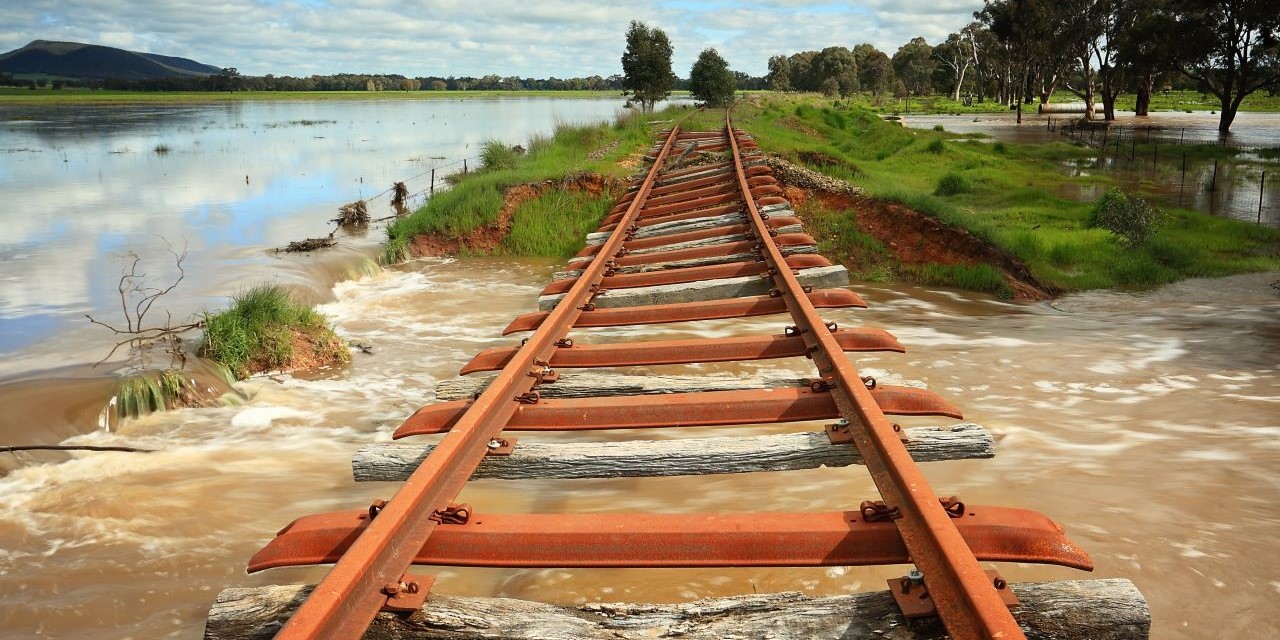Climate Change and Conflict By Tobias Ide | 16 February, 2023
Is Climate Change a Threat to Australia’s National Security?

Image: Flood-damaged railway, NSW Australia - Leah-Anne Thompson/Shutterstock
From climate protestors to the new Teal political movement to leading intelligence experts, Australians are increasingly expressing concerns about the security implications of climate change. This might not be surprising given the long coastline of the country and the frequent occurrence of bushfires, cyclones, droughts, and most recently some of the worst floods in Australia’s history.
A new study provides a comprehensive answer to the question of whether and how climate change undermines Australia’s national security. Previous academic work was mostly scattered across different studies (many behind paywalls and inaccessible to the public). Various NGOs and government institutions stepped up to fill the gap and did some ground-breaking work, but only selectively drew on scientific research. A recent government report on the topic remains classified.
To start with: Already by 2050, average temperatures are predicted to be 1.1°C to 1.5°C higher than today in Australia, weather conditions prone to bushfires will be 8% more likely, flood risks are set to increase considerably, and droughts will undermine agricultural productivity. Taken together, these developments pose a serious threat to human security in terms of human health and economic wellbeing.
Sea-level rise and higher risks of floods, fires, droughts and heatwaves across the country also have serious national security ramifications. According to recent research, two threats are particularly acute.
The first threat refers to climate change disrupting key infrastructure, particularly in the transport and energy sectors. Australia has thousands of kilometres of road, rail and powerlines running along the coast and in areas with high flood or fire risks. By 2050, coastal erosion alone will threaten over 300 police stations, fire stations and healthcare facilities. High demand for air conditioning and fire-induced destruction of energy infrastructure during heatwaves will strain the power grid. More intense tropical storms can destroy multiple forms of infrastructure, as recently witnessed when cyclone Gabrielle hit New Zealand. The list could go on.
Furthermore, the new study identifies the disruption of military capabilities as the second main threat climate change poses to national security. The Australian Defence Force frequently depends on the same infrastructure as civilians, resulting in shared vulnerabilities. The Tanami Road (connecting Alice Springs to the Kimberley), for instance, could be a key strategic asset should Australia need to engage in an international conflict in the Indo-Pacific. However, the road is highly vulnerable to heat and flood damage.
Dedicated military infrastructure is under threat as well. Even though information on this remains partially classified, the Department of Defence considers several of its coastal bases as highly threatened by floods and sea-level rise. On top of that, the Australian Defence Force will need to devote more resources and personnel to disaster responses in a climate-changed world. After extreme events, both domestically and in the Asia-Pacific region, the Australian military is often a key relief provider. When occurring simultaneously or during a time of very high international tensions, these climate change impacts could seriously strain the capabilities of the Australian Defence Force.
Research points to a number of additional threats to national security.
While climate change will not cause international wars, it may well increase the risk of political instability in Australia’s neighbourhood. Large-scale disasters can fuel anti-government sentiments and result in desperate survivors turning to extremist groups for help and income. Experts have also linked disaster-induced migration to communal conflicts in some Pacific Island states. Evidence shows that climate-related disasters are most likely to trigger violent unrest in countries with large populations, political discrimination towards ethnic groups, and low levels of human development. These three factors are quite prevalent in South(east) Asia and the Pacific, including in India, the Philippines, and Papua New Guinea.
The COVID-19 pandemic showed how many countries are heavily reliant on global supply chains. If climate change would facilitate political instability in major oil-producing countries like Nigeria or Iraq, the Australian society, economy and military would need to deal with higher fuel prices. Furthermore, Australia is a major importer of several goods key to its economy and infrastructure, including vehicles, electrical components, and medical products. Many of those good are produced in southwestern China, where a major heatwave recently disrupted industrial production for several days. Such heatwaves, along with floods and storms, will become more frequent in a climate-changed future and can interrupt the supply of goods crucial to civilian, military and economic infrastructure.
The study discusses other national security threats posed by climate change, such as large-scale migration or international fishing disputes, but considers them unlikely or of minor relevance. That said, it is quite clear that already in the coming three decades, climate change will undermine various aspects of Australia’s national security. In order to deal with these impacts, policy makers would be well-advised to pursue a threefold strategy: ambitious climate change mitigation, conflict-sensitive and sustainable adaptation to inevitable climatic changes, and cooperative international peace and development policies.
Tobias Ide is Senior Lecturer in Politics and International Relations at Murdoch University Perth and Adjunct Associate Professor of International Relations at the Brunswick University of Technology. He has published widely on the intersections of the environment, climate change, peace, conflict and security, including in Global Environmental Change, International Affairs, Journal of Peace Research, Nature Climate Change, and World Development. He is also a director of the Environmental Peacebuilding Association.